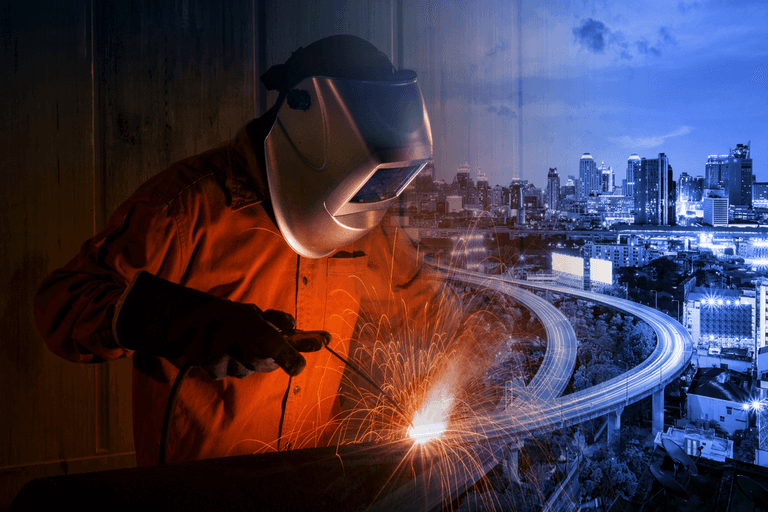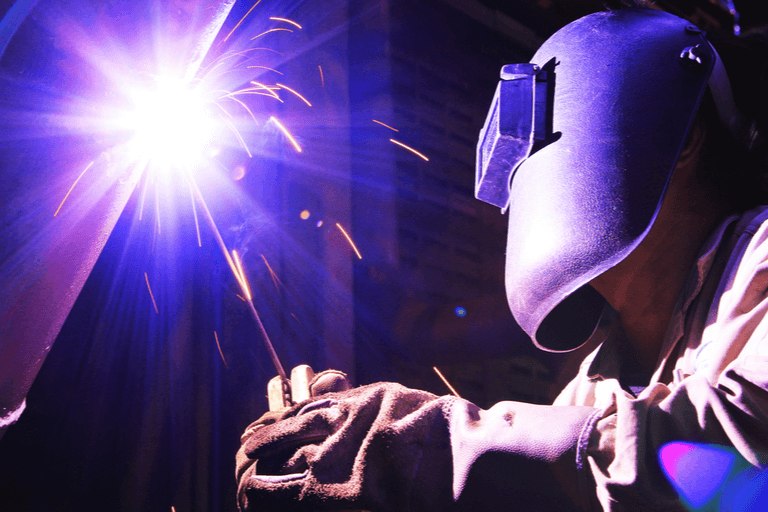WELDING TRAINING
AARON SOLUTION provides Training, Consultation, and other requisite allied services for Welding.
TRAINING
Our exhaustive training covers the following:

Welding procedure specification (WPS):
WPS is the set of standard written instructions to the welder or welding operator that is being followed for making a proper and good quality welding. The purpose of WPS is to direct welders to follow the standard established norms such that recurrent and reliable welding procedures are being used. WPS is different for each metal alloy and for each type of welding.
Procedure qualification record (PQR):
PQR is the record that signifies that the WPS has been followed. All the exact test procedures are recorded during the welding to ascertain that the WPS was followed. Normally additional records like specifications of material, electrode and shielding gas are added as part of PQR. All the necessary tests including X-Ray and ultrasonic examination, tensile, bend and impact tests (if required) are also recorded.
The PQR connects all the detailed information of the WPS and attaches the test reports to provide a complete record that certifies the welding specification.
Welder qualification record (WQR):
The qualification test is conducted for a welder and the details are recorded on a test certificate. The range of his capability is mentioned in the welder qualification record.
Welding inspector training: We at AARON SOLUTION provide an extensively certified welding inspector training.
This training is an extensive summary of the essential standards and fundamentals that every welding inspector should know. Our training incorporates guidelines especially designed to furnish a deeper understanding of the entire knowledge covered in the fundamental elements of the AWS/CSWIP certified welding inspector exam. We have divided the entire course into easy – to – understand short sections, making it easier to grasp.
Welding Safety: Our welding safety follows OSHA (occupational safety and health administration guidelines for training. It includes Fire safety, chemical safety, personal protection, respiratory protection, cylinder safety, oxygen precautions, and electrical safety.
Welding processes:
Shielded metal arc welding (SMAW) – SMAW is the easiest, most affordable, and generally used arc welding process. SMAW also is known as manual arc welding, flux shielded arc welding, or stick welding, is a welding process where electrode covered with flux is used for welding. This process produces a combination of metals by heating them with an arc between a metal electrode and the base metal. Shielding is provided by the disintegration of the electrode. The function of the shielding is to shield the arc and the hot metal from a chemical reaction of the environment. The pressure is not applied in the process. The filler material is available from the electrode.
Gas metal arc welding (GMAW) – (GMAW) is a rapid, cheap welding process also known as a metal inert gas (MIG) welding. In the GMAW process, the base metal and the consumable electrode form an arc providing filler metal for the weld. The electrode does not contain any coating or core. The shielding is provided by either helium, argon, or carbon dioxide gas, thus protecting the molten metal from reacting with the environment. A lot of fumes are generated because of the electrode consumption in this process.
Gas tungsten arc welding (GTAW)– The GTAW process can be used on iron as well as other metals. The non-consumable electrode and the welding metal form an arc between them. A shielding gas forms around the weld area protecting the weld from the environment.
GTAW can be used either with or without filler to weld either a thick or thin metal.The GTAW operation could be either manual or automatic.
Flux cored arc welding (FCAW) – FCAW can either be a semi-automatic or fully automatic welding process. It requires continuous feeding of a tubular electrode having flux and either a constant voltage or sometimes constant current power supply for the welding. The flux generates the necessary protection from the environment since it produces both gaseous as well as liquid slag protection to the welding.
FCAW was developed as an alternative to shielded metal arc welding (SMAW). The stick electrode used in SMAW is not necessary for FCAW.
Submerged arc welding (SAW) – SAW is a general welding process in which the metals are welded by the heat produced with an arc generated between the electrode and the welding metal. The melted weld and the arc are immersed under the blanket of granulated melted flux consisting of calcium fluoride, manganese oxide, silica, and lime which give protection from the atmosphere. The pressure is not used for SAW.
Weld and welding symbols:To limit the amount of words, save space, and time on an engineering drawing welding symbols are used. The welding symbols are used to convey information from the designer to the workman. The welding symbols are used to characterize the welding type, its location, dimensions, boundary, outline, and other additional information.
The weld symbol symbolizes the type of weld required. The welding symbol is a way of representing the weld symbol on the diagrams. There are eight elements necessary in the welding symbol:
- Reference line
- Arrow
- Basic weld symbols
- Dimensions and allied data
- Dimensions and allied data
- Finalization or Finish symbol
- Specification
- Process, or other references.
The weld symbol symbolizes the type of weld required. The welding symbol is a way of representing the weld symbol on the diagrams. There are eight elements necessary in the welding symbol:
Welding Inspection: Technological methods are implemented to ascertain the quality of welding, confirm the presence, location, and coverage of the welds. Because the welding might face loads and fatigues at the usage during the lifetime.
Welding technology:Welding technology leads to better craftmanship and creating perfect welding.
New technology is cheaper, gives better quality, improves productivity and can be more competitive.
New developments in remote control welding technologies have a lot of advantages at remote sites. The welding operators have full control over the welding guidelines from a remote place. This leads to less wastage of time due to travel and hence, more productivity. Remote control welding technology increases safety.
Newer welding technology like push-button changeover and digital interfaces have made the welding process more automatic and timesaving thereby increasing productivity.
WELDING SERVICE
We at AARON SOLUTION provide welding services in the following:
- Procedure qualification
- Welder qualification
- Welding consultancy
- Welding consultancy: ISO 3834 is an exhaustive list of guidelines with respect to welding.
- EN 1090 consultancyThe EN 1090 are recognised by the construction and products regulation. They are European standards regulating the fabrication and assembly of aluminium and steel structures.
EN 1090 consists of three parts:
- EN 1090-1: CE-marking. Compatibility evaluation for fabrication components.
- EN 1090-2: Technical requirements for steel structure execution.
- EN 1090-3: Technical requirements for aluminium structure execution.
ISO 15085: The ISO 15085 is a set of guidelines applicable for the designing, manufacturing, testing and compatibility evaluation of the welding in railway vehicles, parts and assemblies. It also sets guidelines for the quality system, approval of the welding process, and welder and welding operator’s performance qualification records.

